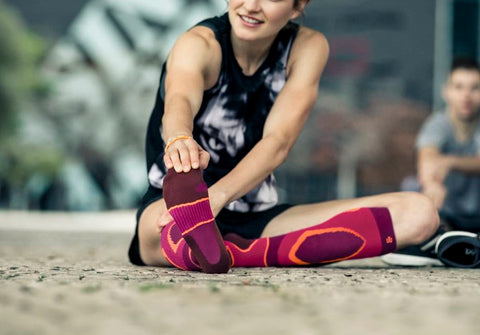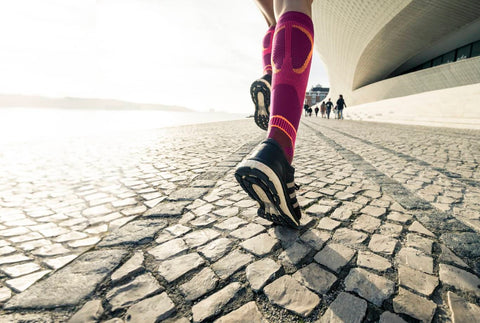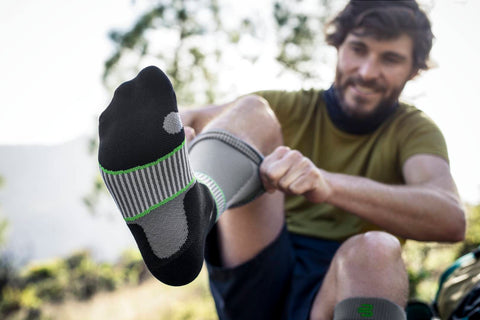Why you should wear sports compression socks
They protect the toes
The toes are rarely the first thing you’d think to protect during physical exercise. And it’s true that with the right shoes, these digits can generally get by fine on their own without much help. However, many sports like tennis, basketball, and football can put pressure on the toes. For example, when you suddenly stop after a dead sprint, your toe can jam into the top of your shoe. And when this happens too often, you might end up with a gnarly case of tennis toe. That’s why quality sports compression socks like our Performance Socks have built-in padding around the toes for extra protection.

Performance Socks
Boost blood flow
When you exercise, your heart doesn’t have much trouble pumping blood into your extremities. However, as the volume of blood it pumps increases, your veins may find it hard to keep up. That's why strenuous activities like weightlifting can make your veins bulge out.
Sports compression socks help by gradually squeezing the muscles, moving blood out of overflowing venules into your deep trunk veins and up toward the heart. With this increased venous return, your muscles get more oxygen and nutrients. And with more oxygen and nutrients, they’ll be slower to fatigue and faster to recover. Do note, however, that some manufacturers use the term “compression” loosely.
Learn more: Types of medical grade compression
Reduce muscle oscillation
Muscle oscillation (the often-uncomfortable vibrations that shoot up your leg when your foot hits the ground) may feel like a manageable discomfort and might not seem like such a bad thing. But as noted in a study featured by the Society of Biomechanics in Sports, it can actually increase muscle fatigue and the risk of microtrauma to the muscular tissues. According to the same study, compression garments reduce the risk by compressing the muscle and improving muscle activation (AKA proprioception).
As you can imagine, runners (especially those who run on hard terrain like concrete) benefit the most from reduced oscillation. However, the general proprioceptive benefits of compression socks will be great for any sport or activity requiring a lot of running and jumping.
Stabilise the ankle
If you need to run, jump, or make sharp turns (especially if you have some ankle instability from an old injury), you’ll benefit from compression socks. Unlike some traditional ankle braces, they’ll support your ankle "internally" rather than externally.
Improved proprioception means the muscles running through the ankle and connecting to the foot and calf will activate more effectively, helping them act as better, more stable supports for the joint. Some socks (like our own Performance Socks) also have built-in arch support to stabilise the arch of the foot and further support the ankle.
Support the foot
Outdoor Socks
Sports compression socks also help support the foot as they often have built-in support zones. Our Outdoor and Performance Socks, for example, have the quintessential arch supports. They also have support zones around the heel, Achilles, and sole, helping relieve the irritation and pressure often felt around those areas.
With these protections in place, you’ll be able to play longer with less risk of injuries like Achilles tendonitis and plantar fasciitis.
Moisture wicking + breathable
Last but not least, some sports compression socks go the extra mile by being made of breathable, moisture-wicking fabric. So, even during strenuous activities, you’ll have less sweat build-up and, by extension, less chance of blisters and foul foot smell.
Some things to consider about your sports compression socks
When shopping for any type of compression garment, you’ll need to keep a few things in mind.
- Fit: your socks should fit you perfectly. Too tight, and they can hinder blood flow instead of helping it. Too loose, and they won’t be effective. Additionally, all the support zones need to be in the right places for maximum effect. (that’s why we have extensive sizing and measuring guides).
- Material: they should also be of medical-grade stock and around 20 mmHg (that’s millimetres of mercury, or how "compressive" the socks are.) A pair of quality compression socks should last you 6 months. If they’re not high quality, they will start to feel loose after just a few washes.
- Purpose: socks designed for sports work a bit differently from socks designed for, say, varicose veins. Sports socks have all the extra bits and bobs to support the foot through movement and generally a lower grade of compression. High compression grades are only really necessary for serious venous conditions and lymphedema.
- Style: all our sports socks protect the toes and feet. But for obvious reasons, ankle socks won’t have the same benefits for the calves as knee-high ones do.
To sum up
Contrary to some myths and claims floating around on the internet, compression socks won't drastically improve your sports performance. However, they will help reduce muscle fatigue and improve muscle activation, giving you more energy and stability. Not to mention, they'll help you better protect your foot, ankle, and calf, reducing your risk of injury. For maximum effectiveness, though, you'll need to ensure your socks are made of the right stuff and are the right fit for you.
See our Performance Compression range: Sports Compression Sleeves






















